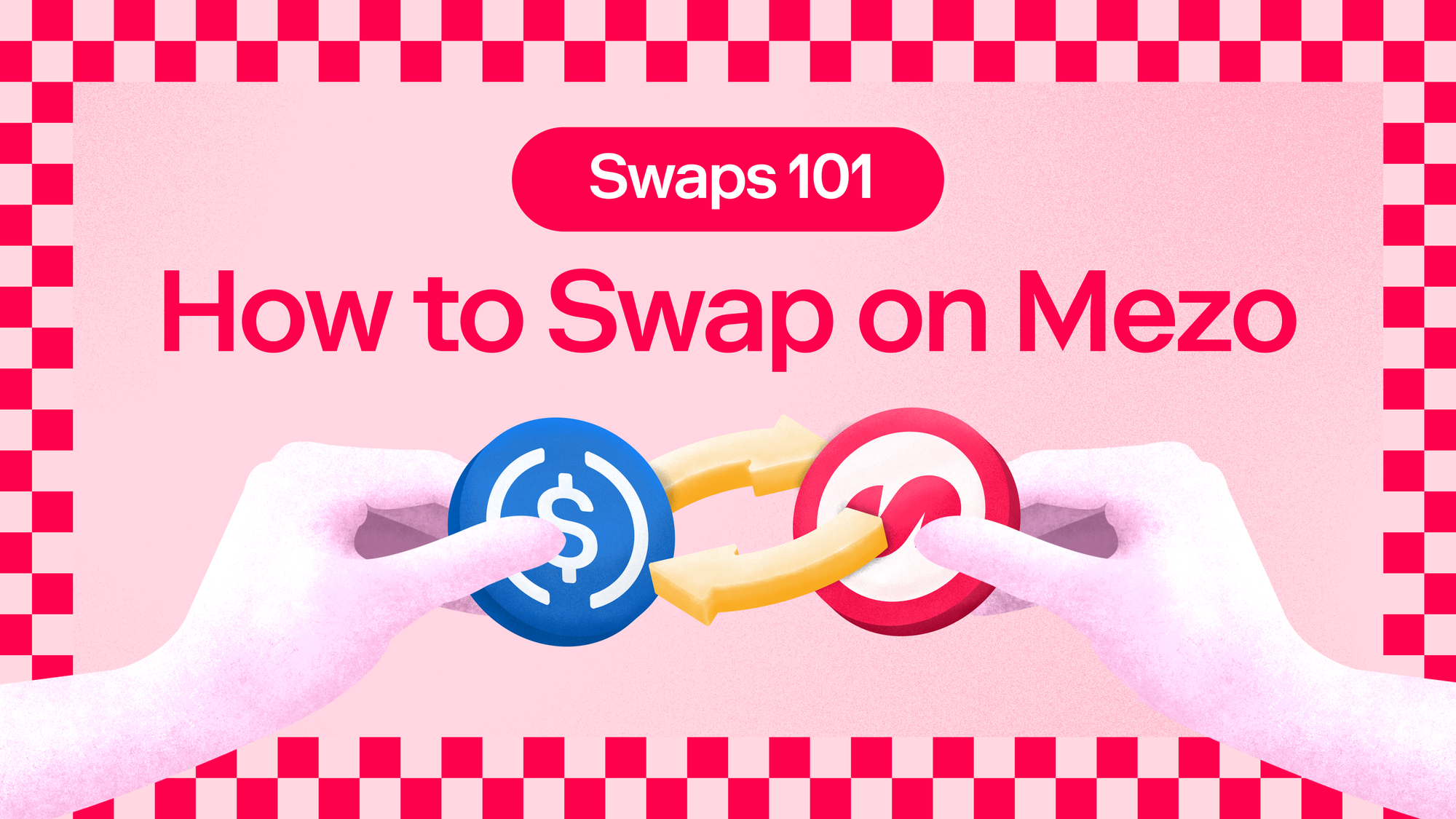Mezo 101: Step-by-Step Guide to Swapping Crypto on Mezo
This guide walks you through using Mezo Swap to trade between BTC, MUSD, USDC, and USDT without leaving the Mezo app.

Mezo Swap is the integrated decentralized exchange (DEX) that lets you instantly trade between assets on Mezo. No order books, no intermediaries, no KYC—just permissionless swaps powered by liquidity pools.
You can use Mezo Swap to:
- Convert borrowed MUSD into BTC or stablecoins
- Swap BTC into MUSD to repay a loan or deposit into a savings vault
- Move between stablecoins (MUSD, USDC, USDT) for different use cases
- Rebalance your position after market movements
Swapping currently earns you mats rewards, making each trade productive beyond the swap itself.
Before You Start
Make sure you have:
- A connected wallet with assets on Mezo
- At least one supported asset (BTC, MUSD, USDC, or USDT)
Enough BTC to cover gas fees (network transactions are paid in BTC on Mezo)
If you haven't bridged assets to Mezo yet, deposit first through the main portal at mezo.org.
Using the Swap Interface
Watch the video below to see each step in action, or follow along with the step-by-step.
Step 1: Access Mezo Swap
Click the Swap button in the top right corner of your Mezo dashboard. This opens the swap interface.
Step 2: Select Your Assets
The swap interface has two sections: From and To.
- From: Choose the asset you want to swap. Your current balance appears in the top right.
- To: Choose the asset you want to receive.
Currently supported assets:
- BTC
- MUSD
- USDC
- USDT
Enter the amount you want to swap in the From field. The To field automatically calculates how much you'll receive based on current pool prices.
Step 3: Review Swap Details
Before confirming, check the following information displayed in the interface:
- Rate: The exchange rate between your two assets (e.g., 1 BTC = 150,000 MUSD). This rate updates in real-time based on pool liquidity.
- Slippage: The maximum price movement you're willing to accept. Default slippage is 0.5% for stablecoin pairs (MUSD/USDC) and 1% for volatile pairs (BTC/MUSD). You can adjust this by clicking the slippage setting. Higher slippage tolerance means your transaction is more likely to succeed during volatile markets, but you might get a less favorable rate. Lower slippage protects you from price changes but might cause your transaction to fail if the market moves.
- Fees: Two types of fees apply:
- Protocol Fee: 0.05% for stable pairs (MUSD/USDC), 0.3% for volatile pairs (BTC/MUSD). These fees go to liquidity providers.
- Network Fee: Standard gas fee for executing the transaction on-chain, paid in BTC.
- Amount to Receive: The final amount after fees and slippage, showing exactly what will land in your wallet.
Step 4: Execute the Swap
Once you've reviewed everything, click Approve to initiate the swap.
Your wallet will prompt you to confirm the transaction. Review the gas cost and approve. The swap typically processes within seconds, and you'll see a confirmation once complete.
After the Swap
Your new asset balance appears immediately in your Mezo wallet. You can:
- View your transaction on the Mezo explorer by clicking the transaction link
- Check your updated asset balances in the Overview section
All swaps are recorded on-chain and fully transparent. You can verify any transaction using the Mezo block explorer.
Tips for Smooth Swapping
Watch Your Slippage: Large trades can experience more slippage due to their price impact on the pool. If you're swapping a large amount, consider breaking it into smaller trades or checking the pool's total liquidity first.
Check Pool Liquidity: Head to Mezo Pools to view the total value locked (TVL) in each pool. Higher liquidity means less slippage for your trades.
Mind Your Gas: Gas fees are paid in BTC on Mezo. Always keep some BTC in your wallet to cover transaction costs. If you're swapping all your BTC for another asset, make sure to leave enough for gas.
Use Stable Pairs for Better Rates: Swapping between stablecoins (MUSD/USDC or MUSD/USDT) uses a specialized stable swap curve designed to minimize slippage. These pairs typically offer better execution than volatile pairs.
Failed Transactions: If your transaction fails, it's usually due to:
- Insufficient gas
- Slippage tolerance too low for current market conditions
- Insufficient liquidity in the pool
Try increasing your slippage tolerance slightly or reducing your trade size.
Next Steps
Now that you know how to swap on Mezo, you can:
- Deposit MUSD into the Vault to earn sustainable yield from DeFi strategies, tBTC rewards, and mats
- Provide liquidity to Mezo Pools to earn a share of protocol swap fees and mats rewards
- Use MUSD for everyday spending through Bitrefill gift cards or other integrations
- Repay or adjust your loan position using swapped assets
Every action on Mezo earns you mats, building your stake in the protocol while using your Bitcoin productively.
Ready to get started? 🔄 Start swapping • 📚 Read the docs • 💬 Join Discord
